
Using the limit equilibrium method for assessing slope failure conditions in an archaeological site of the 4th century B.C.
Luigi Coppola(*), Pierfrancesco Rescio(**) & Marcello Bianc (***)
(*) Department of Geological Science, University of Basilicata, Potenza, Italy. E-mail: coppola@unibas.it
(**) University of Suor Orsola Benincasa, Napoli, Italy.
(***) Department of Structures, Geotechnics, Engineering Geology, University of Basilicata, Potenza, Italy.
Volume: 129 (2010) f.2
Pages: 327-334
Abstract
The impact on the territory of important archaeological sites and related human activities has induced, as a rule, modifications in the local environmental system. An example is represented by the sanctuary of the goddess Mefitis in Macchia Rossano, in the territory of Vaglio Basilicata, close to the town of Potenza (southern Italy). This archaeological site has been affected by swelling in historical times that occurred in the allochthonous, chaotic, heterogeneous, and anisotropic polychrome scaly clays of the geological formation called Argille Varicolori. In such structural conditions, the collapse mechanisms of the Argille Varicolori seem to be strongly influenced by pre-failure phenomena and, therefore, the application of the limit equilibrium method does not always seem to be suitable. Nonetheless, the analysis in terms of total stress and the in situ assessment of the relationship between rainfall and fluctuations of the groundwater level by long-term monitoring have allowed to determine the amount of rainfall related to the piezometric level of collapse and, consequently, to assess the conditions of the sanctuary in the historical times when the landslides occurred.
Keywords
Get Full Text